Previous issues
- Page Path
- HOME > Browse Articles > Previous issues
- [Korean]
- Effects of Particle Size and Binder Phase Addition on Formability of Li-Si Alloy Powder for Thermal Battery Anode
- Sung-Soo Ryu, Hui-Sik Kim, Seongwon Kim, Hyung-Tae Kim, Hae-Won Cheong, Sung-Min Lee
- J Korean Powder Metall Inst. 2014;21(5):331-337. Published online October 1, 2014
- DOI: https://doi.org/10.4150/KPMI.2014.21.5.331
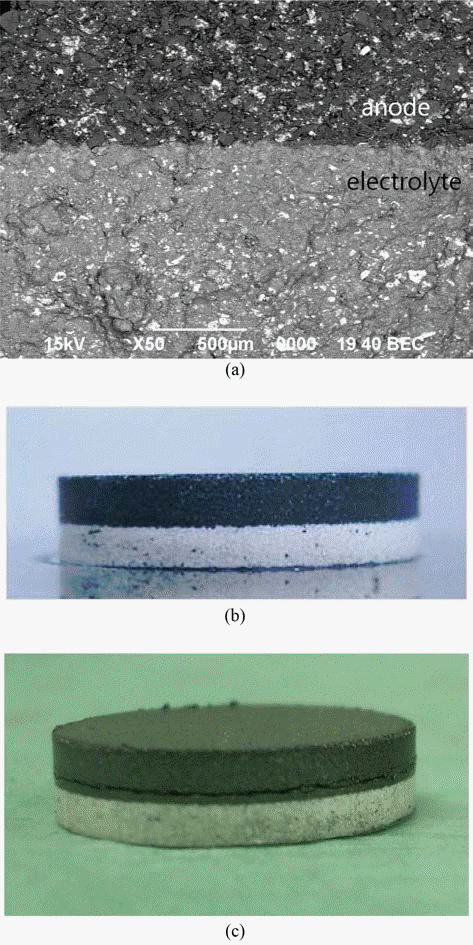
- 469 View
- 7 Download
-
 Abstract
Abstract
 PDF
PDF The effects of particle size of Li-Si alloy and LiCl-KCl addition as a binder phase for raw material of anode were investigated on the formability of the thermal battery anode. The formability was evaluated with respect to filling density, tap density, compaction density, spring-back and compressive strength. With increasing particle size of Li-Si alloy powder, densities increased while spring-back and compressive strength decreased. Since the small spring-back is beneficial to avoiding breakage of pressed compacts, larger particles might be more suitable for anode forming. The increasing amount of LiCl-KCl binder phase contributed to reducing spring-back, improving the formability of anode powder too. The control of particle size also seems to be helpful to get double pressed pellets, which consisted of two layer of anode and electrolyte.
- [Korean]
- Mechanical Alloying of GaSe and GaTe Systems
- Jung Bo Choi, Jung-Ho Ahn
- J Korean Powder Metall Inst. 2014;21(5):338-342. Published online October 1, 2014
- DOI: https://doi.org/10.4150/KPMI.2014.21.5.338
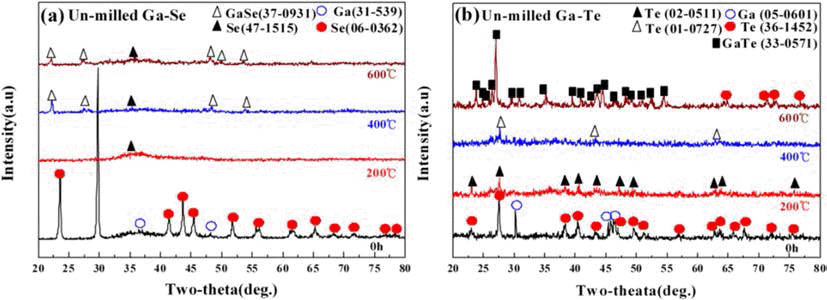
- 406 View
- 0 Download
- 1 Citations
-
 Abstract
Abstract
 PDF
PDF In the present work, we investigated the mechanical alloying of binary Ga-Se(1:1) and Ga-Te(1;1) sysyems. The high-energy ball-milling was performed at 40°C where one of constituents (Ga) is molten state. The purpose of the work was to see whether reactions between constituent elements are accelerated by the presence of a liquid phase. During the ball-milling, the liquid Ga phase completely disappeared and the resulting powders consist of nanocrystalline grain of ~20 nm with partly amorphized phases. However, no intermetallic compounds formed in spite of the presence of the liquid phases which has much higher diffusivity than solid constituents. By subsequent heat-treatments, the inter-metallic compounds such as GaSe and GaTe formed at relatively low temperatures. The formation temperature of theses compound was much lower than those predicted by equilibrium phase diagram. The comparison of the ball-milled powders with un-milled ones indicated that the easy formation of intermetallic compound or allying occurs at low temperatures.
-
Citations
Citations to this article as recorded by- A Study on Synthesis of Ni-Ti-B Alloy by Mechanical Alloying from Elemental Component Powder
Jung Geun Kim, Yong Ho Park
Journal of Korean Powder Metallurgy Institute.2016; 23(3): 202. CrossRef
- A Study on Synthesis of Ni-Ti-B Alloy by Mechanical Alloying from Elemental Component Powder
- [Korean]
- Microstructure and Mechanical Properties of CNT/Al Composite Fabricated by a Powder-in-Sheath Rolling Method utilizing Copper Tube as a Sheath
- Seong-Hee Lee
- J Korean Powder Metall Inst. 2014;21(5):343-348. Published online October 1, 2014
- DOI: https://doi.org/10.4150/KPMI.2014.21.5.343
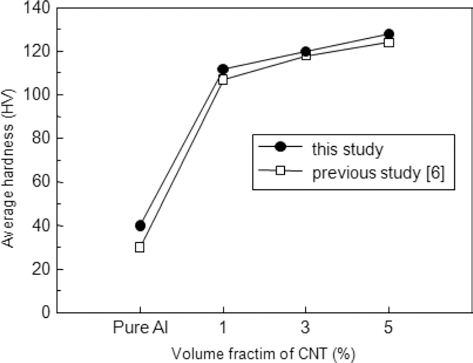
- 424 View
- 0 Download
-
 Abstract
Abstract
 PDF
PDF A powder-in-sheath rolling (PSR) process utilizing a copper alloy tube was applied to a fabrication of a multi-walled carbon nanotube (CNT) reinforced aluminum matrix composite. A copper tube with an outer diameter of 30 mm and a wall thickness of 2 mm was used as a sheath material. A mixture of pure aluminum powders and CNTs with the volume contents of 1, 3, 5 vol% was filled in the tube by tap filling and then processed to 93.3% height reduction by a rolling mill. The relative density of the CNT/Al composite fabricated by the PSR decreased slightly with increasing of CNTs content, but showed high value more than 98%. The average hardness of the 5%CNT/Al composite increased more than 3 times, compared to that of unreinforced pure Al powder compaction. The hardness of the CNT/Al composites was some higher than that of the composites fabricated by PSR using SUS304 tube. Therefore, it is concluded that the type of tube affects largely on the mechanical properties of the CNT/Al composites in the PSR process.
- [Korean]
- Manufacturing of Cu Repair Coating Material Using the Kinetic Spray Process and Changes in the Microstructures and Properties by Heat Treatment
- Min-Gwang Jeon, Hyung-Jun Kim, Kee-Ahn Lee
- J Korean Powder Metall Inst. 2014;21(5):349-354. Published online October 1, 2014
- DOI: https://doi.org/10.4150/KPMI.2014.21.5.349
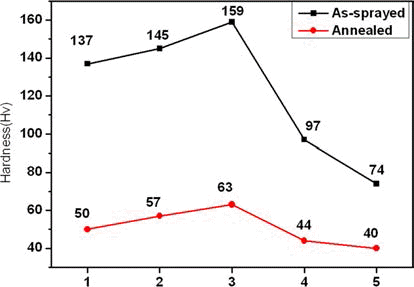
- 493 View
- 0 Download
- 4 Citations
-
 Abstract
Abstract
 PDF
PDF This study is a basic research for repair material production which manufactured a Cu repair coating layer on the base material of a Cu plate using kinetic spray process. Furthermore, the manufactured material underwent an annealing heat treatment, and the changes of microstructure and macroscopic properties in the Cu repair coating layer and base material were examined. The powder feedstocks were sphere-shaped pure Cu powders with an average size of 27.7 μm. The produced repair coating material featured 600 μm thickness and 0.8% porosity, and it had an identical α-Cu single phase as the early powder. The produced Cu repair coating material and base material displayed extremely high adhesion characteristics that produced a boundary difficult to identify. Composition analysis confirmed that the impurities in the base material and repair coating material had no significant differences. Microstructure observation after a 500°C/1hr. heat treatment (vacuum condition) identified recovery, recrystallization and grain growth in the repair coating material and featured a more homogeneous microstructure. The hardness difference (ΔHv) between the repair coating material and base material significantly reduced from 87 to 34 after undergoing heat treatment.
-
Citations
Citations to this article as recorded by- Manufacturing of Large-Scale Cold-Sprayed Ta Target Material and Its Sputtering Property
Gi-Su Ham, Dong-Yeol Wi, Jun-Mo Yang, Kee-Ahn Lee
Journal of Thermal Spray Technology.2019; 28(8): 1974. CrossRef - High-temperature thermo-mechanical behavior of functionally graded materials produced by plasma sprayed coating: Experimental and modeling results
Kang Hyun Choi, Hyun-Su Kim, Chang Hyun Park, Gon-Ho Kim, Kyoung Ho Baik, Sung Ho Lee, Taehyung Kim, Hyoung Seop Kim
Metals and Materials International.2016; 22(5): 817. CrossRef - Fabrication and Microstructure/Properties of Bulk-typeTantalum Material by a Kinetic Spray Process
Ji-Hye Lee, Ji-Won Kim, Kee-Ahn Lee
Journal of Korean Powder Metallurgy Institute.2016; 23(1): 8. CrossRef - Effect of Heat Treatment Environment on the Microstructure and Properties of Kinetic Sprayed Tantalum Coating Layer
Ji-Hye Lee, Hyung-Jun Kim, Kee-Ahn Lee
Journal of Korean Powder Metallurgy Institute.2015; 22(1): 32. CrossRef
- Manufacturing of Large-Scale Cold-Sprayed Ta Target Material and Its Sputtering Property
- [Korean]
- Controlling Structural and Electrical Properties of Pt Nanopowder-Dispersed SiO2 Film
- Jae Ho Lee, In Joo Shin, Sung Woo Lee, Hyeong Cheol Kim, Byung Joon Choi
- J Korean Powder Metall Inst. 2014;21(5):355-359. Published online October 1, 2014
- DOI: https://doi.org/10.4150/KPMI.2014.21.5.355
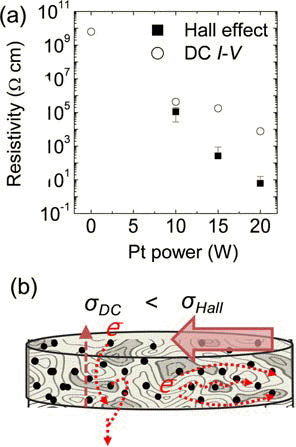
- 304 View
- 0 Download
-
 Abstract
Abstract
 PDF
PDF Pt nanopowder-dispersed SiO2 (SOP) films were prepared by RF co-sputtering method using Pt and SiO2 targets in Ar atmosphere. The growth rate and Pt content in the film were controlled by means of manipulating the RF power of Pt target while that of SiO2 was fixed. The roughness of the film was increased with increasing the power of Pt target, which was mainly due to the increment of the size and planar density of Pt nanopowder. It was revealed that SOP film formed at 10, 15, 20 W of Pt power contained 2.3, 2.7, and 3.0 nm of spherical Pt nanopowder, respectively. Electrical conductivity of SOP films was exponentially increased with increasing Pt power as one can expect. Interestingly, conductivity of SOP films from Hall effect measurement was greater than that from DC
I-V measurement, which was explained by the significant increase of electron density.
- [Korean]
- Synthesis and Characterization of SnO2-CoO/carbon-coated CoO Core/shell Nanowire Composites
- Yu-Jin Lee, Bon-Ryul Koo, Hyo-Jin Ahn
- J Korean Powder Metall Inst. 2014;21(5):360-365. Published online October 1, 2014
- DOI: https://doi.org/10.4150/KPMI.2014.21.5.360
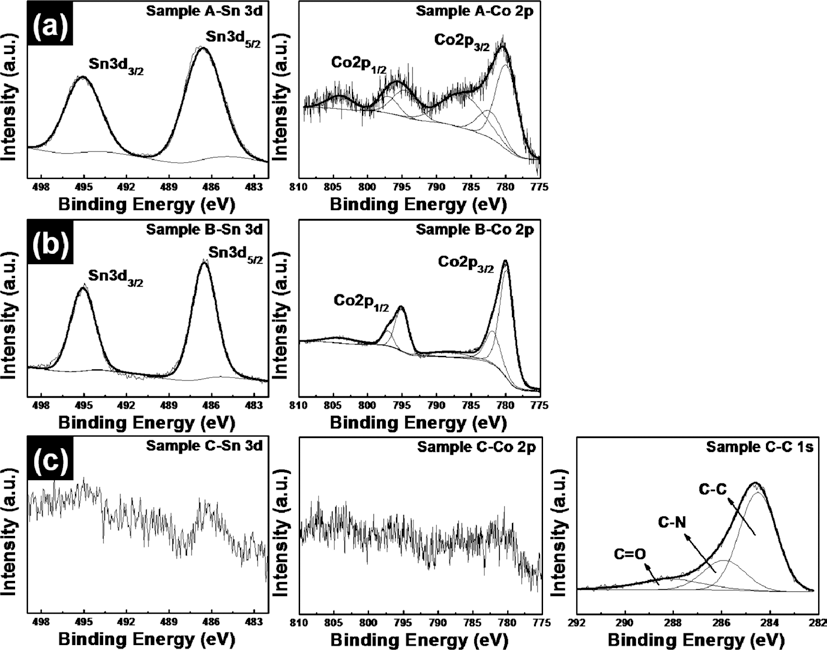
- 382 View
- 0 Download
- 2 Citations
-
 Abstract
Abstract
 PDF
PDF SnO2-CoO/carbon-coated CoO core/shell nanowire composites were synthesized by using electrospinning and hydrothermal methods. In order to obtain SnO2-CoO/carbon-coated CoO core/shell nanowire composites, SnO2-Co3O4 nanowire composites and SnO2-Co3O4/polygonal Co3O4 core/shell nanowire composites are also synthesized. To demonstrate their structural, chemical bonding, and morphological properties, field-emission scanning electron microscopy, transmission electron microscopy, X-ray diffraction, and X-ray photoelectron spectroscopy were carried out. These results indicated that the morphologies and structures of the samples were changed from SnO2-Co3O4 nanowires having cylindrical structures to SnO2-Co3O4/Co3O4 core/shell nanowires having polygonal structures after a hydrothermal process. At last, SnO2-CoO/carbon-coated CoO core/shell nanowire composites having irregular and high surface area are formed after carbon coating using a polypyrrole (PPy). Also, there occur phases transformation of cobalt phases from Co3O4 to CoO during carbon coating using a PPy under a argon atmosphere.
-
Citations
Citations to this article as recorded by- Co-Embedded Graphitic Porous Carbon Nanofibers for Pt-Free Counter Electrode in Dye-Sensitized Solar Cells
혜란 안, 혜린 강, 효정 선, 지호 한, 효진 안
Korean Journal of Materials Research.2015; 25(12): 672~677. CrossRef - Synthesis of Perforated Polygonal Cobalt Oxides usinga Carbon Nanofiber Template
Dong-Yo Sin, Geon-Hyoung An, Hyo-Jin Ahn
Journal of Korean Powder Metallurgy Institute.2015; 22(5): 350. CrossRef
- Co-Embedded Graphitic Porous Carbon Nanofibers for Pt-Free Counter Electrode in Dye-Sensitized Solar Cells
- [Korean]
- Effect of Solidification Condition of Sublimable Vehicles on the Pore Characteristics in Freeze Drying Process
- Myung-Jin Suk, Ji Soon Kim, Sung-Tag Oh
- J Korean Powder Metall Inst. 2014;21(5):366-370. Published online October 1, 2014
- DOI: https://doi.org/10.4150/KPMI.2014.21.5.366
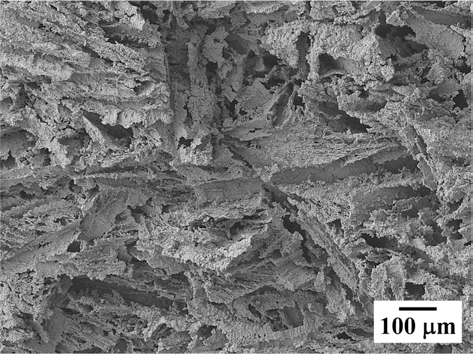
- 428 View
- 0 Download
- 2 Citations
-
 Abstract
Abstract
 PDF
PDF The present study demonstrates the effect of solidification condition on the pore structure in freeze drying process using the slurries of CuO/sublimable vehicles. Camphene and Camphor-45 wt% naphthalene based slurries with 14 vol% CuO powder were frozen into a mold at -25°C, followed by sublimation at room temperature. The green bodies were hydrogen-reduced and sintered at 500°C for 1 h. The porous Cu specimen, frozen the CuO/camphene slurry into the heated mold of the upper part, showed large pores with unidirectional pore channels and small pores in their internal wall. Also, it was observed that the size of large pores was decreasing near the bottom part of specimen. The change of pore structure depending on the freezing condition was explained by the nucleation behavior of camphene crystals and rearrangement of solid powders during solidification. In case of porous Cu prepared from CuO/Camphornaphthalene system, the pore structure exhibited plate shape as a replica of the original structure of crystallized vehicles with hypereutectic composition.
-
Citations
Citations to this article as recorded by- Interaction of Solid Particles with the Solidifying Front in the Liquid-Particle Mixture
Ho-Suk Lee, Kyu-Hee Lee, Sung-Tag Oh, Young Do Kim, Myung-Jin Suk
Journal of Korean Powder Metallurgy Institute.2018; 25(4): 336. CrossRef - Fabrication of Ti Porous body with Improved Specific Surface Area by Synthesis of CNTs
Hye Rim Choi, Jong Min Byun, Myung-Jin Suk, Sung-Tag Oh, Young Do Kim
Journal of Korean Powder Metallurgy Institute.2016; 23(3): 235. CrossRef
- Interaction of Solid Particles with the Solidifying Front in the Liquid-Particle Mixture
- [Korean]
- CNT Growth Behavior on Ti Substrate by Catalytic CVD Process with Temperature Gradient in Tube Furnace
- Ju Hyuk Park, Jong Min Byun, Hyung Soo Kim, Myung-Jin Suk, Sung-Tag Oh, Young Do Kim
- J Korean Powder Metall Inst. 2014;21(5):371-376. Published online October 1, 2014
- DOI: https://doi.org/10.4150/KPMI.2014.21.5.371
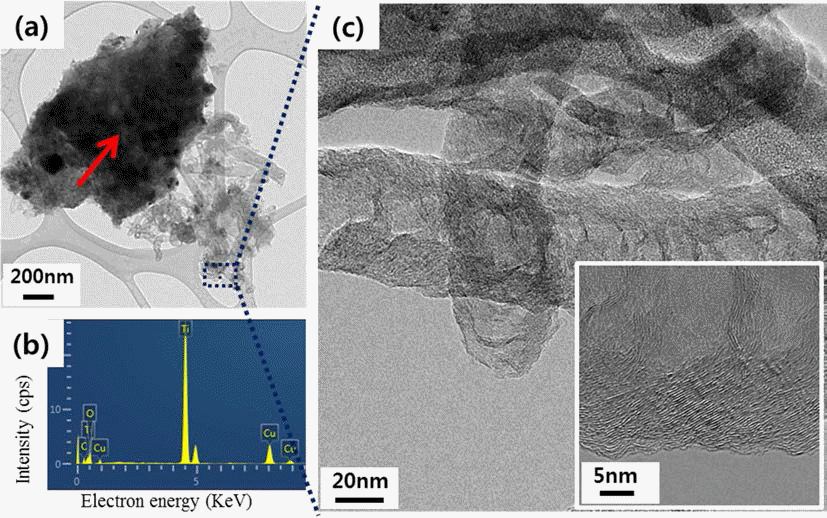
- 647 View
- 2 Download
- 2 Citations
-
 Abstract
Abstract
 PDF
PDF In this study, modified catalytic chemical vapor deposition (CCVD) method was applied to control the CNTs (carbon nanotubes) growth. Since titanium (Ti) substrate and iron (Fe) catalysts react one another and form a new phase (Fe2TiO5) above 700°C, the decrease of CNT yield above 800°C where methane gas decomposes is inevitable under common CCVD method. Therefore, we synthesized CNTs on the Ti substrate by dividing the tube furnace into two sections (left and right) and heating them to different temperatures each. The reactant gas flew through from the end of the right tube furnace while the Ti substrate was placed in the center of the left tube furnace. When the CNT growth temperature was set 700/950°C (left/right), CNTs with high yield were observed. Also, by examining the micro-structure of CNTs of 700/950°C, it was confirmed that CNTs show the bamboo-like structure.
-
Citations
Citations to this article as recorded by- Fabrication of Ti Porous body with Improved Specific Surface Area by Synthesis of CNTs
Hye Rim Choi, Jong Min Byun, Myung-Jin Suk, Sung-Tag Oh, Young Do Kim
Journal of Korean Powder Metallurgy Institute.2016; 23(3): 235. CrossRef - Synthesis of CNT on a Camphene Impregnated Titanium Porous Body by Thermal Chemical Vapor Deposition
Hogyu Kim, Hye Rim Choi, Jong Min Byun, Myung-Jin Suk, Sung-Tag Oh, Young Do Kim
Journal of Korean Powder Metallurgy Institute.2015; 22(2): 122. CrossRef
- Fabrication of Ti Porous body with Improved Specific Surface Area by Synthesis of CNTs
- [Korean]
- Coloration and Chemical Stability of SiO2 and SnO2 Coated Blue CoAl2O4 Pigment
- JiYeon Yun, Ri Yu, Jae-Hwan Pee, YooJin Kim
- J Korean Powder Metall Inst. 2014;21(5):377-381. Published online October 1, 2014
- DOI: https://doi.org/10.4150/KPMI.2014.21.5.377
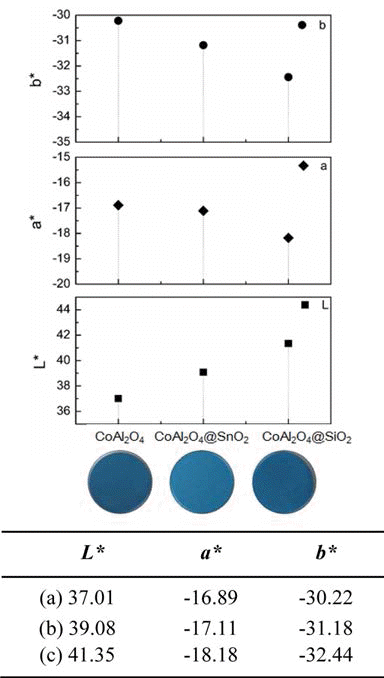
- 437 View
- 1 Download
-
 Abstract
Abstract
 PDF
PDF This work describes the coloration, chemical stability of SiO2 and SnO2-coated blue CoAl2O4 pigment. The CoAl2O4, raw materials, were synthesized by a co-precipitation method and coated with silica (SiO2) and tin oxide (SnO2) using sol-gel method, respectively. To study phase and coloration of CoAl2O4, we prepared nano sized CoAl2O4 pigments which were coated SiO2 and SnO2 using tetraethylorthosilicate, Na2SiO3 and Na2SnO3 as a coating material. To determine the stability of the coated samples and their colloidal solutions under acidic and basic conditions, colloidal nanoparticle solutions with various pH values were prepared and monitored over time. Blue CoAl2O4 solutions were tuned yellow color under all acidic/basic conditions. On the other hand, the chemical stability of SiO2 and SnO2-coated CoAl2O4 solution were improved when all samples pH values, respectively. Phase stability under acidic/basic condition of the core-shell type CoAl2O4 powders were characterized by transmission electron microscope, X-ray diffraction,
CIE L*a*b* color parameter measurements.
- [Korean]
- Spark Plasma Sintering of Fe-TiC Composite Powders
- Yong-Heui Lee, Xuan-Khoa Hyunh, Ji Soon Kim
- J Korean Powder Metall Inst. 2014;21(5):382-388. Published online October 1, 2014
- DOI: https://doi.org/10.4150/KPMI.2014.21.5.382
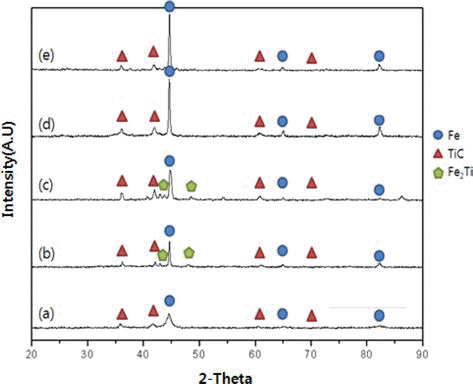
- 594 View
- 2 Download
- 3 Citations
-
 Abstract
Abstract
 PDF
PDF Fe-TiC composite powder was fabricated by high-energy milling of powder mixture of (Fe, TiC) and (FeO, TiH2, C) as starting materials, respectively. The latter one was heat-treated for reaction synthesis of TiC phase after milling. Both powders were spark-plasma sintered at various temperatures of 680-1070°C for 10 min. with sintering pressure of 70 MPa and the heating rate of 50°C/min. under vacuum of 0.133 Pa. Density and hardness of the sintered compact was investigated. Fe-TiC composite fabricated from (FeO, TiH2, C) as starting materials showed better sintered properties. It seems to be resulted from ultra-fine TiC particle size and its uniform distribution in Fe-matrix compared to the simply mixed (Fe, TiC) powder.
-
Citations
Citations to this article as recorded by- Comparative study of Ni-TaC composites via high-energy ball milling activation and spark plasma sintering: Reinforcement, densification, oxidation resistance, and mechanical property
Bum-Soon Park, Jeong-Han Lee, Jae-Cheol Park, Hyun-Kuk Park
Journal of Alloys and Compounds.2024; 984: 173900. CrossRef - Effect of TiC particle size on high temperature oxidation behavior of TiC reinforced stainless steel
Yeong-Hwan Lee, Sungmin Ko, Hyeonjae Park, Donghyun Lee, Sangmin Shin, Ilguk Jo, Sang-Bok Lee, Sang-Kwan Lee, Yangdo Kim, Seungchan Cho
Applied Surface Science.2019; 480: 951. CrossRef - Effect of TiC addition on surface oxidation behavior of SKD11 tool steel composites
Seungchan Cho, Ilguk Jo, Heebong Kim, Hyuk-Tae Kwon, Sang-Kwan Lee, Sang-Bok Lee
Applied Surface Science.2017; 415: 155. CrossRef
- Comparative study of Ni-TaC composites via high-energy ball milling activation and spark plasma sintering: Reinforcement, densification, oxidation resistance, and mechanical property
- [English]
- Processing Methods for the Preparation of Porous Ceramics
- Rizwan Ahmad, Jang-Hoon Ha, In-Hyuck Song
- J Korean Powder Metall Inst. 2014;21(5):389-398. Published online October 1, 2014
- DOI: https://doi.org/10.4150/KPMI.2014.21.5.389
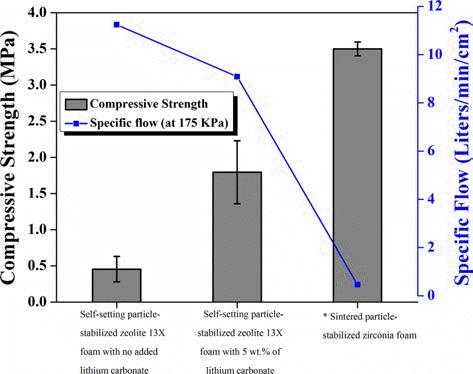
- 2,453 View
- 71 Download
- 21 Citations
-
 Abstract
Abstract
 PDF
PDF Macroporous ceramics with tailored pore size and shape could be used for well-established and emerging applications, such as molten metal filtration, biomaterial, catalysis, thermal insulation, hot gas filtration and diesel particulate filters. In these applications, unique properties of porous materials were required which could be achieved through the incorporation of macro-pores into ceramics. In this article, we reviewed the main processing techniques which can be used for the fabrication of macroporous ceramics with tailored microstructure. Partial sintering, replica templates, sacrificial fugutives, and direct foaming techniques was described here and compared in terms of micro-structures and mechanical properties that could be achieved. The main focus was given to the direct foaming technique which was simple and versatile approach that allowed the fabrication of macro-porous ceramics with tailored features and properties.
-
Citations
Citations to this article as recorded by- Contribution of microscale stochastic truss models to investigate the macroscale elasticity constants of porous ceramics
Thierry Canet, Gilles Dusserre, Thierry Cutard
European Journal of Mechanics - A/Solids.2025; 111: 105561. CrossRef - Synthesis and properties of high alumina cement-based porous composites in the ZrO2-CaO-Al2O3 system
Yesica L. Bruni, María F. Hernández, Susana Conconi, Gustavo Suárez
Ceramics International.2025; 51(23): 39794. CrossRef - Organic waste-derived pore formers for macroporous ceramics fabrication: A review on synthesis, durability properties and potential applications
T.T. Dele-Afolabi, M.A. Azmah Hanim, A.A. Oyekanmi, M.N.M. Ansari, Surajudeen Sikiru, O.J. Ojo-Kupoluyi
Materials Today Sustainability.2024; 27: 100824. CrossRef - Chemistry and Physics of Wet Foam Stability for Porous Ceramics: A Review
Kamrun Nahar Fatema, Md Rokon Ud Dowla Biswas, Jung Gyu Park, Ik Jin Kim
Micro.2024; 4(4): 552. CrossRef - Investigating mass transfer coefficients in lean methane combustion reaction through the morphological and geometric analysis of structured open cell foam catalysts
Carmen W. Moncada Quintero, Hernan G. Mazzei, Marion Servel, Frédéric Augier, Yacine Haroun, Jean-François Joly, Stefania Specchia
Chemical Engineering Science.2023; 281: 119138. CrossRef - Composite PLGA–Nanobioceramic Coating on Moxifloxacin-Loaded Akermanite 3D Porous Scaffolds for Bone Tissue Regeneration
Georgia K. Pouroutzidou, Lambrini Papadopoulou, Maria Lazaridou, Konstantinos Tsachouridis, Chrysanthi Papoulia, Dimitra Patsiaoura, Ioannis Tsamesidis, Konstantinos Chrissafis, George Vourlias, Konstantinos M. Paraskevopoulos, Antonios D. Anastasiou, Dim
Pharmaceutics.2023; 15(3): 819. CrossRef - Development of high strength large open porosity alumina ceramics using the sacrificial phase route: The role of the sacrificial phase fineness
Julian Alzukaimi, Rafi Jabrah
Ceramics International.2023; 49(2): 2923. CrossRef - Sustainable nanocomposite porous absorbent and membrane sieves: Definition, classification, history, properties, synthesis, applications, and future prospects
Sameer Ahmad, Weqar Ahmad Siddiqi, Sharif Ahmad
Journal of Environmental Chemical Engineering.2023; 11(2): 109367. CrossRef - Processing and characterization of porous composites based on CaAl4O7/CaZrO3
Yesica L. Bruni, María S. Conconi, María F. Hernández, Gustavo Suárez
Ceramics International.2023; 49(23): 37630. CrossRef - Trace addition of cellulose nanofiber in gel-casting system for structurally controlled porous ceramics towards superior thermal-insulating property
Yunzi Xin, Takashi Shirai
Journal of the Ceramic Society of Japan.2022; 130(5): 355. CrossRef - State-of-the-art review of fabrication, application, and mechanical properties of functionally graded porous nanocomposite materials
Ismail Barbaros, Yongmin Yang, Babak Safaei, Zhicheng Yang, Zhaoye Qin, Mohammed Asmael
Nanotechnology Reviews.2022; 11(1): 321. CrossRef - A review of petroleum emulsification types, formation factors, and demulsification methods
Ahmed Abdulrazzaq Hadi, Ali Abdulkhabeer Ali
Materials Today: Proceedings.2022; 53: 273. CrossRef - SLURRY OPTIMISATION FOR FAST FREEZE-DRYING OF POROUS ALUMINA
Kritkaew Somton
Ceramics - Silikaty.2021; : 368. CrossRef - Recycling food, agricultural, and industrial wastes as pore-forming agents for sustainable porous ceramic production: A review
Siti Zuliana Salleh, Afiqah Awang Kechik, Abdul Hafidz Yusoff, Mustaffa Ali Azhar Taib, Maryana Mohamad Nor, Mardawani Mohamad, Tse Guan Tan, Arlina Ali, Mohamad Najmi Masri, Julie Juliewatty Mohamed, Siti Koriah Zakaria, Jia Geng Boon, Faisal Budiman, Pa
Journal of Cleaner Production.2021; 306: 127264. CrossRef - Novel noble-metal-free ceramic filter with controlled pore structure for environmental cleaning
Yunzi Xin, Sohei Nakagawa, Harumitsu Nishikawa, Takashi Shirai
Ceramics International.2021; 47(8): 11819. CrossRef - Fabrication of porous titania sheet via tape casting: Microstructure and water permeability study
Saber Ghannadi, Hossein Abdizadeh, Alireza Babaei
Ceramics International.2020; 46(7): 8689. CrossRef - Farklı Bağlayıcı ve Sinterleme Katkılarının SiC Seramik Prefom Mikroyapısı Üzerine Etkisi
Ebru Yılmaz, Fatih Çalışkan
Academic Perspective Procedia.2019; 2(3): 1309. CrossRef - The preparation and characterization of porous alumina ceramics using an eco‐friendly pore‐forming agent
Julian Alzukaimi, Rafi Jabrah
International Journal of Applied Ceramic Technology.2019; 16(2): 820. CrossRef - Wet Foam Stability from Colloidal Suspension to Porous Ceramics: A Review
Ik Jin Kim, Jung Gyu Park, Young Han Han, Suk Young Kim, James F. Shackelford
Journal of the Korean Ceramic Society.2019; 56(3): 211. CrossRef - Processing of porous alumina by foaming method-effect of foaming agent, solid loading and binder
Soumya Devavarapu, Paritosh Chaudhuri, Aroh Shrivastava, Santanu Bhattacharyya
Ceramics International.2019; 45(9): 12264. CrossRef - Macroporous flexible polyvinyl alcohol lithium adsorbent foam composite prepared via surfactant blending and cryo-desiccation
Grace M. Nisola, Lawrence A. Limjuco, Eleazer L. Vivas, Chosel P. Lawagon, Myoung Jun Park, Ho Kyong Shon, Neha Mittal, In Wook Nah, Hern Kim, Wook-Jin Chung
Chemical Engineering Journal.2015; 280: 536. CrossRef
- Contribution of microscale stochastic truss models to investigate the macroscale elasticity constants of porous ceramics
TOP
 kpmi
kpmi




 First
First Prev
Prev


